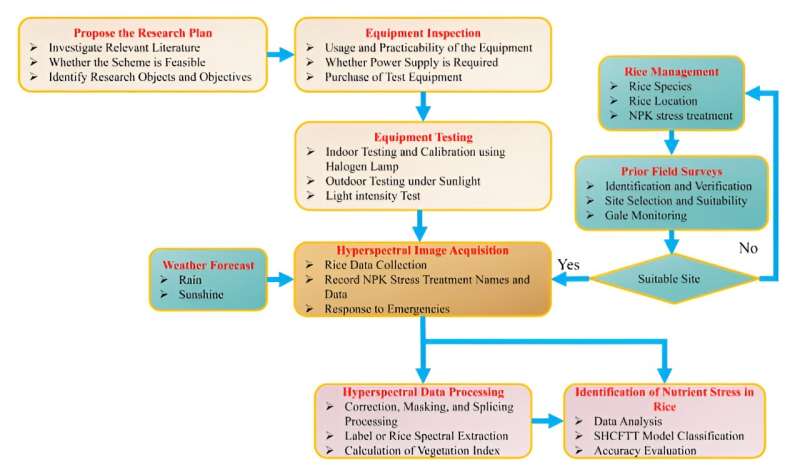This article has been reviewed according to Science X's editorial process and policies. Editors have highlighted the following attributes while ensuring the content's credibility:
fact-checked
trusted source
proofread
A research team develops hyperspectral library for rice nutrient stress

A research team has developed a hyperspectral library for 14 NPK nutrient stress conditions in rice, using a terrestrial hyperspectral camera to collect and analyze 420 rice stress images. The transformer-based deep learning network SHCFTT accurately identified nutrient stress patterns, outperforming SVM, 1D-CNN, and 3D-CNN models with an accuracy ranging from 93.92% to 100%. This method enhances the precision of nutrient stress detection, contributing to improved crop health monitoring and decision-making in precision agriculture.
Rice is a vital crop for global development, but its yield and quality are threatened by various stresses, particularly nutrient stress. Traditional methods for monitoring crop stress are labor-intensive and time-consuming. While remote sensing technology shows promise, it faces challenges such as atmospheric conditions and mixed farmland communities.
Current research highlights the potential of deep learning, particularly Transformer architecture, to enhance hyperspectral imaging (HSI) analysis. However, studies combining deep learning with HSI for identifying rice NPK stress are lacking.
A study published in Plant Phenomics on 29 May 2024, aims to address this gap by developing a deep learning classification network based on CNN and Transformer architecture to accurately identify nutrient stress patterns in rice using terrestrial hyperspectral images.
A research team used HSI collected by SPECIM IQ to analyze rice under different nutrient stresses, calculating vegetation indices (NDVI, PRI, PSRI) to identify stress patterns. The normalized difference vegetation index (NDVI) highlighted trends in nitrogen (N) stress, showing varying values across different treatments.
The photochemical reflectance index (PRI) and plant senescence reflectance index (PSRI) effectively indicated potassium (K) stress levels. These indices provided a detailed view of the spectral response of rice canopies under nutrient stress.
To further analyze the data, an unsupervised visualization process was employed, revealing complex clustering scenarios and demonstrating the need for advanced modeling to differentiate stress types. The study then proposed a deep learning network, SHCFTT, combining CNN and Transformer architectures to classify nutrient stress patterns from hyperspectral images.
Ablation tests confirmed the model's effectiveness, showing significant improvements in classification accuracy when key modules were included. The SHCFTT model outperformed traditional methods, achieving overall accuracy (OA) and average accuracy (AA) up to 100% in both single-year and biennial datasets. Even with limited training samples, SHCFTT maintained high accuracy, proving its robustness and potential for practical applications.
According to the study's lead researcher, Zhentao Wang, "The proposal of these methods not only has a positive effect on identifying nutrient stress in rice but also has implications for monitoring and decision-making of crop health status in the field and precision agriculture.
"In addition, this was a typical case study of rice nutrition coercion in highly diverse and intense field conditions. Contributed to the development of hyperspectral imaging crop phenotype research and precision agriculture field information perception."
In summary, this research offers a reliable approach for monitoring rice health and managing nutrient stress, contributing to better crop management and precision agriculture. Future studies will focus on extending the algorithm to different crops and optimizing attention mechanisms for enhanced performance.
More information: Jinfeng Wang et al, Characterization and identification of NPK stress in rice using terrestrial hyperspectral images, Plant Phenomics (2024). DOI: 10.34133/plantphenomics.0197
Provided by Chinese Academy of Sciences





















